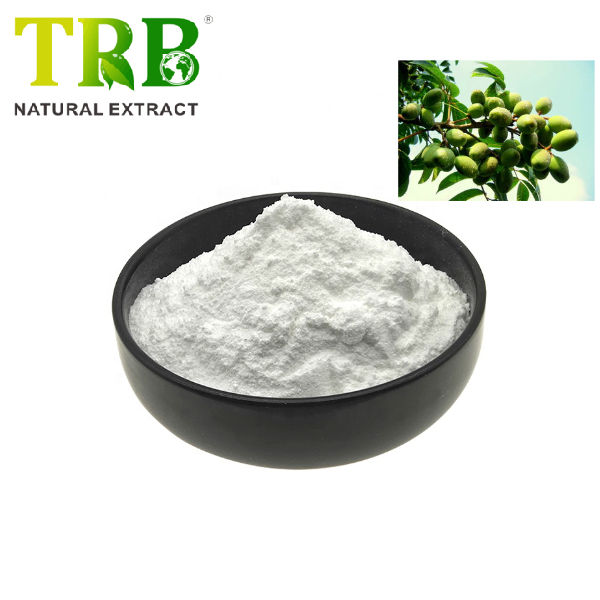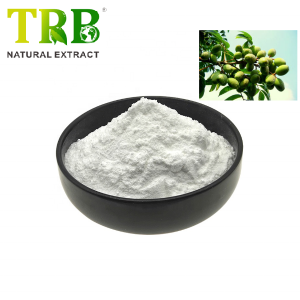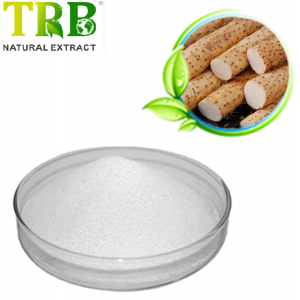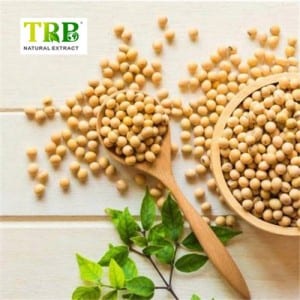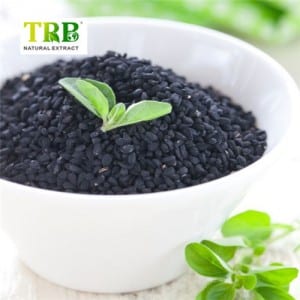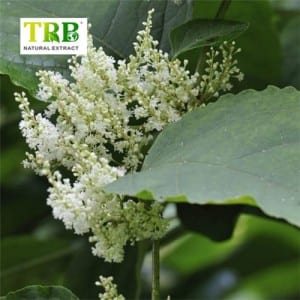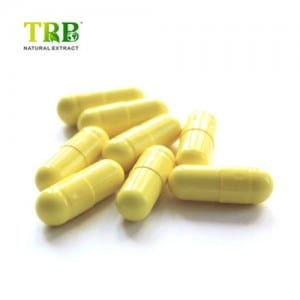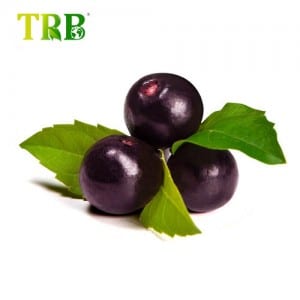El ácido oleanólico, que está a tres triterpenoides pentacíclicos aisladas de plantas Gentianaceae de Swertia mileensis toda la hierba o aligustre fruta, con un cuerpo libre y glucósidos en muchas plantas. El ácido oleanólico tiene una amplia gama en las plantas, y el contenido medio es 0,2% - 2%. Cucurbitaceae alto contenido es 1,5% ~ jorobado parte inferior 2%, aligustre contenido de fruta de 0,6% ~ 0,7% de ácido .Oleanolic es un tipo de compuesto triterpenoides pentacíclico aislado de la fruta del género Asteraceae, Syzygium sylvestris, o Ligustrum lucidum. Es un adyuvante enfermedad hepática y clínicamente utilizado para la infección terapéutica. Hepatitis ictericia aguda tiene efectos obvios sobre la reducción de la alanina aminotransferasa y ácido yellowing.Oolic es un triterpenoides pentacíclicos aisladas a partir de la fruta de chinensis swertia o fructus ligustris de la planta gentianaceae. El ácido oleanólico se encuentra ampliamente en plantas, con un contenido general de 0,2% ~ 2% [1]. El contenido de fondo de calabaza era 1,5% ~ 2%, y el contenido de fruta de ligustris fructus era 0,6% ~ 0,7%. El ácido oleanólico es cristal blanco acicular (etanol), inodoro e insípido. Inestable a los ácidos y bases. Punto de 308 ~ 310 de fusión ℃, [alfa] 20 D + 73,3 ° (c = 0,15, cloroformo, insoluble en agua, soluble en metanol, etanol, éter etílico, acetona y ácido chloroform.Oleanolic es una triterpenoides de origen natural, ampliamente distribuida en alimentos y plantas medicinales, relacionados con el ácido betulínico. se puede encontrar en Phytolacca americana (pokeweed americano), y Syzygium spp, ajo, etc. es relativamente no tóxico, hepatoprotector, y exhibe propiedades antitumorales y antivirales.
El ácido oleanólico era encontrado que exhiben una fuerte actividad anti-VIH, se usó el ácido betulínico compuesto relacionado para crear el primer fármaco inhibidor de la maduración comercial. se estudió primero y aislado de varias plantas, incluyendo Rosa woodsii (hojas), Prosopis glandulosa (hojas y ramitas), Phordendron juniperinum (planta entera), Syzygium claviflorum (hojas), hyptis capitata (planta entera), y gymnanthera Ternstromia (parte aérea). Otras especies de Syzygium incluyendo manzana de java (Syzygium samarangense) y la manzana de rosa s lo contienen.
Nombre del producto: ácido oleanólico 98 %
Especificación: 98% por HPLC
Botánico Fuente: Extracto de Olea Europea
Nombre químico: (3β) -3-Hydroxyolean-12-en-28-oico
CAS: 508-02-1
Parte usada: Hoja
Color: polvo blanco con olor y sabor característicos
Estado OGM: Libre de Transgénicos
Embalaje: 25kgs en tambores de fibra
Almacenamiento: Mantener el envase cerrado, en lugar fresco y seco, Manténgase alejado de la luz fuerte
Vida útil: 24 meses desde la fecha de fabricación
What is oleanolic acid?
Oleanolic acid (OA), a natural hydroxyl pentacyclic triterpenoid acid (HPTA) similar to betulinic acid, ursolic acid; it has benefits like antibacterial, anti-inflammatory, antitumor activities.

Where can you find oleanolic acid?
Oleanolic acid has used traditionally for the treatment of various diseases,you can find it in food and plants widely.
Some fruits like apples, pomegranate, lemon, bilberries, olives contain oleanolic acid too.

| Herb Name | Oleanolic acid content | Test method |
| Ligustrum lucidum Ait | 0.8028% | HPLC |
| Verbena Officinalis L | 0.071%-0.086% | HPLC |
| Prunella vulgaris L | 3.47%-4.46% | HPLC |
| Hemsley Chinensis Cogn. | 1.5%~2% | HPLC |
Currently, Chinese herb Hemsley Chinensis Cogn still is the most commercial raw material for extracting oleanolic acid.
Hemsley Chinensis Cogn. Introduction
Hemsleya chinensis Cogn. is a perennial climbing herb, also is traditional Chinese medicine.
Familia: Cucurbitaceae
Tribus: Gomphogyneae
Genus: Hemsleya
Species: H. amabilis
The herb is distributed in provinces Guangxi, Sichuan, Guizhou, Yunnan, Hubei, etc. Born in the forest edge and valley shrubs at an altitude of about 2,000 meters.
Active ingredients: contains Hemslolide Mal、Ma3、H1; Chikusetsusaponin-Iva; dihydro cucurbitacin F-25-acetate; dilydrocucurbitacin F; oleanolic acid-beta-Hlucosyloleanolate; Hemsamabilinin A; Cu-curbitacinⅡb-2-beta-D-glucopyranoside.
Medicinal Values:
Hemsleya chinensis Cogn. is mainly for detoxification, sterilization, anti-inflammatory, strengthening the stomach and relieving pain. Currently, there are extracts powder, or compound preparations such as capsules, tablets, gastrointestinal pills, etc., which are widely used in clinical practice.

Extraction of Oleanolic acid from Hemsleya Chinensis Cogn.

Formulas containing Oleanolic acid in Food supplements
We found that the oleanolic acid used in health supplements mainly comes from three kinds of plant extracts: Loquat leaf extract, Hemsley Chinensis extract, and holy basil extract.
- Holy Basil powder (leaf) (0.4% Ursolic acid and Oleanolic acid, 2.0 mg)
- Holy Basil supercritical CO2 extract (leaf) (Ocimum tenuiflorum Linn.) (2.5% Ursolic acid and Oleanolic acid, 1.5 mg)
- Loquat Extract (fruit) (providing Ursolic acid, Oleanolic Acid) (Standardized to Ursolic acid Per Serving 125mg)

Oleanolic acid VS Ursolic acid
Oleanolic acid (OA) and ursolic acid (UA) are natural triterpenoids that have a similar chemical structure.
These triterpenoids compounds are known to exist in medicinal herbs and foods.
They have many common pharmacological properties: hepatoprotective, anti-inflammatory, antimicrobial, hypoglycemic, antimutagenic, anti-HIV activity, antioxidant, and antifertility activities.

OA and UA difference:
| Nombre del producto | Oleanolic acid | Ursolic acid |
| CAS NO. | 508-02-1 | 77-52-1 |
| Pentacyclic triterpenes | β-Amyrin | α-Amyrin |
| Herb sources | Loquat leaf, Holy Basil, Rosemary, Olive leaf.etc. | |
| Specifications | 40%,98%powder | 15%,25%,50%,98%powder |
| Appearance(color and odor) | 40% light yellow98%white powderodorless | 15%-50% brown-yellow or yellow98%white powderCharacteristic |
| Distinguishing | IR:(1355~1392cm-1) two peaks(1245~1330cm-1) three peaksNMR:δ(C12)122.1,δ(C13)143.4 | (1355~1392cm-1) three peaks(1245~1330cm-1) three peaksδ(C12)125.5,δ(C13)138.0 |
| Derivatives | Oleanolic sodium saltOleanolic acid phosphate disodium salt3-oxo oleanolic acid
bardoxolone methyl (CDDO-Me) |
Ursolic sodium salt and its dicarboxylic acid half ester derivativesUrsolic acid ketene derivatives3-carbon ursolic acid
3-acetoxyursolic acid |
| Potential anticancer | UA is more popular than OA. | |
Biological Activities of Oleanolic Acid
-
Anti-Tumour/Anti-Cancer Effects
Inhibitory effect of oleanolic acid on hepatocellular carcinoma via ERK-p53-mediated cell cycle arrest and mitochondrial-dependent apoptosis
– by Xin Wang, Hua Bai, etc. Researchers
OA exhibited an inhibitory effect on HCC through induction of apoptosis and cell cycle arrest both in transplanted tumors and in HepG2 cells.
OA induced apoptosis through the mitochondrial pathway, evidenced by inhibition of Akt/mammalian target of rapamycin pathway.
OA induced G2/M cell cycle arrest through p21-mediated down-regulation of cyclin B1/cdc2.
OA demonstrated significant antitumor activities in HCC in vivo and in vitro models. These data provide new insight into the mechanisms underlying the antitumor effect of OA.
In addition, research shows that OA and its derivative Oleanolic acid methyl ester also have effects on breast cancer, lung cancer, bladder cancer, cervical cancer, pancreatic cancer cells…

-
Antimicrobial Activity
OA is expected to possess antimicrobial activity against a wide range of pathogens for it plays a vital role in defending against pathogens in plants.
OA showed moderate activity against Staphylococcus aureus and Bacillus Thuringiensis at 62.5 µg/mL and Escherichia coli, Salmonella Enterica, and Shigella dysenteriae at 31.2 µg/mL minimum inhibitory concentration (MIC).
-
Hepatoprotective Ability
One of the notable bioactivities of OA is the protection of the liver against toxicity and is currently being used as an over the hepatic counter drug in China.
In Wistar albino rats, OA from Flaveria Trinervia was used and had a significant protective effect on ethanol-induced liver toxicity by restoring the hepatotoxic serum marker enzyme levels. This study suggested the antioxidant ability of OA as another possible mechanism of its hepatoprotective ability.
Oleanolic Acid and its derivatives

Oleanolic Acid Clinical Trials
Oleanolic acid (sourced from olive), there are about 500 registered clinical trials, showed it had beneficial effects in clinical trials on chronic kidney disease, diabetes mellitus type 2, and some inflammatory conditions such as arthritis.
Most popular derivatives in clinical trials are bardoxolone methyl (CDDO-Me). CDDO-Me was evaluated in tumor biopsies, and it might be able to play a role in the treatment of chronic kidney disease, it is currently being assessed in effects on hypertension.
Chinese Pharmacopoeia Standard of Oleanolic Acid
| Nombre del producto | Oleanolic Acid |
| Identificación | (1)Take 30mg of this product, put it in a test tube, add 3ml of chloroform to dissolve, add two drops of sulfuric acid, shake for 5 minutes, the chloroform layer is purple-red. |
| (2)Take about 20mg of this product, add 1ml of acetic anhydride, dissolve it with a slight heat, add sulfuric acid to the purple color, and darken after placing. | |
| (3)Take about 10mg of this product, add vanillin glacial acetic acid solution (take vanillin 0.5g, add 10ml of glacial acetic acid to dissolve, that is) 0.2ml, add 0.8ml of perchloric acid, and heat it for several minutes in a water bath. Fuchsia, add 2ml of ethyl acetate, purple-red dissolved in ethyl acetate, placed without discoloration. | |
| (4)The infrared absorption spectrum of this product should be consistent with the control spectrum. | |
| Determination of assay | Take 0.15g of this product, accurately weigh it, add 30ml of ethanol, shake it, heat it in a warm water bath to dissolve, let cool to room temperature, add 3 drops of phenolphthalein indicator solution, make potassium hydroxide solution with ethanol (0.05mol/L) Titrate immediately and correct for blank test. Potassium hydroxide solution (0.05 mol/L) per 1 ml of ethanol corresponds to 22.84 mg of C30H 48O 3. |
Oleanolic acid recommend dosage
According to the Chinese Pharmacopoeia Standard, Oleanolic acid Oral dose is 20~80mg per time,60~240mg per day.
Oleanolic acid side effects
Oleanolic acid used as an over the counter (OTC) hepatoprotective drug for decades in China.
If overdose or incorrect, a small number of patients have dry mouth, diarrhea, upper abdominal discomfort, and can disappear after symptomatic treatment.
Please consult your physician or pharmacist before using this product.
Función:
Ácido 1.Oleanolic es relativamente no tóxico, antitumoral, y hepatoprotector, además de exhibir propiedades antivirales.
Se encontró ácido 2.Oleanolic a exhibir una fuerte actividad anti-VIH.
Ácido 3.Oleanolic es un protector importante de las células contra el estrés oxidativo y electrófilo.
Ácido 4.Oleanolic tiene un gran efecto sobre trar virus de la hepatitis, hepatitis ictérica aguda y hepatitis crónica.
Solicitud:
1. aplicada en el campo de la alimentación, que puede actúa como materias primas de té para reducir la flema;
2. Aplicada en el campo farmacéutico, se convierte en un nuevo fármaco anti-cáncer con baja toxicidad;
3. Aplicada en el campo cosmético, se puede vigorizar la circulación sanguínea y eliminar bebida.
|
Más información de TRB |
||
| certificación Reglamento | ||
| USFDA, CEP, Halal KOSHER GMP Certificados ISO | ||
| Calidad confiable | ||
| Casi 20 años, de exportación 40 países y regiones, más de 2000 lotes producidos por TRB no tienen problemas de calidad, proceso de purificación única, la impureza y el control de pureza se reúnen USP, EP y CP | ||
| Sistema de Calidad Integral | ||
|
|
▲ Sistema de Aseguramiento de Calidad |
√ |
| ▲ Control de documentos |
√ |
|
| ▲ Sistema de Validación |
√ |
|
| ▲ Sistema de Entrenamiento |
√ |
|
| ▲ Protocolo de Auditoría Interna |
√ |
|
| ▲ Sistema de Auditoría Suppler |
√ |
|
| ▲ Equipo Instalaciones Sistema |
√ |
|
| ▲ Sistema de Control de Materiales |
√ |
|
| ▲ Sistema de Control de Producción |
√ |
|
| ▲ Sistema de etiquetado de embalaje |
√ |
|
| ▲ Sistema de Control de Laboratorio |
√ |
|
| ▲ Sistema de Validación Verificación |
√ |
|
| ▲ Sistema de Asuntos Regulatorios |
√ |
|
| Controlar las fuentes de enteros y Procesos | ||
| Estrictamente controladas todas las materias primas, accesorios y embalaje materials.Preferred proveedor de materiales y accesorios y materiales de embalaje en bruto de EE.UU. DMF number.Several proveedores de materias primas como el aseguramiento de suministro. | ||
| Las cooperativas fuertes como para soportar | ||
| Instituto de Botánica / Institución de la microbiología / Academia de Ciencias y Tecnología / Universidad | ||
